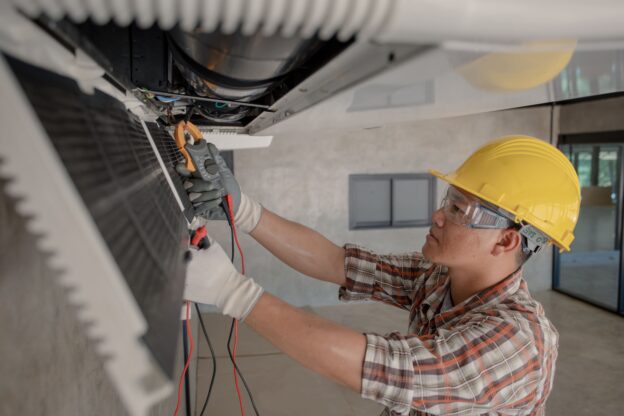June 2018 – This article is the second in a series showing how best practices tools can be used to improve building maintenance performance. By benchmarking the building maintenance performance and applying specific filters you will see which maintenance best practices have the most impact.
Other articles in this series include:
Based on Figure 1 the maintenance cost for our facility is $2.46 per square foot and the median value is $2.41 per square foot. Our building’s cost is shown in yellow and is just above median cost. Costs could be improved, and management has asked for options that would lower our maintenance costs to first-quarter performance or about $1.87 per square foot. But where to make the improvements? It is obvious that improvements can be made but we need to evaluate the best practices to see which would be the most effective at improving performance.

Filters: Type of facility (Office)
Provided courtesy of FM BENCHMARKING.
This is where benchmarking of best practices can lead us to make good decisions on which programs would have the most impact. So let’s look at the best practices of the buildings in our some filter (comparison) set that are spending less than we are for our building.
Consider Figure 2 below. This shows the percent of Maintenance Best Practices implemented by the peers in our building’s quartile (3) compared to the percent implemented by the next better quartile (2).

Filters: Type of facility (Office)
Provided courtesy of FM BENCHMARKING.
Based on the percent of implementation difference it would seem that “MB04 – Equipment standards for replacement components…” would have the greatest impact since it has the greatest percentage difference and the greatest differential.
Now, let’s apply some other filters to see if the results change (since different best practices would seem to make more sense in some buildings than others, we would expect them to change based on building variables). In Figure 3 below we applied an additional filter of building age “21-50 years” since our building is 38 years old.
The maintenance costs for older buildings is a little higher with the median value of $2.52 per square foot. This has the effect of moving our facility into the second quartile, as many of the better-performing buildings were newer buildings.

Filters: Type of facility (Office), Age (21-50 years)
Provided courtesy of FM BENCHMARKING.
Comparing best practices implemented by our second quartile peer group should be interesting. The implementation rate changes significantly for “MB03 – Electronic handheld devices…” there is a 73% implementation rate in the second quartile but a 97% implementation rate in the first quartile. The gap is really significant!

Filters: Type of facility (Office), Age (21-50 years)
Provided courtesy of FM BENCHMARKING.
This would seem to be a best practice that should be implemented to move the organization toward first quartile performance.
Only a few best practices have been discussed here. There are 19 maintenance best practices in the maintenance module, and others show equally high percentage variations. Clearly this is an effective way to identify options that would provide successful results to improve performance.




